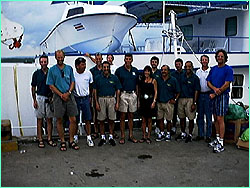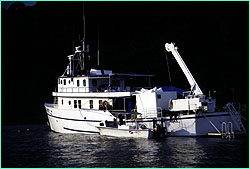 |
 |
 |
by Peter Tyson September 25, 1998 I knew weather would be a factor on this expedition to Cocos Island. After all, the place gets enough rain in a year to fill up a two-story house well into the attic, and it's still the rainy season. I just didn't expect weather to be a factor so soon. On Wednesday, I got a call from Michele Hall. I said I was looking forward to meeting her and the rest of the IMAX film crew in Miami Thursday evening. Won't happen, Michele said. Hurricane Georges, if it kept to its current course, would strike southern Florida sometime Thursday evening, just in time for our 7 p.m. flight to San Jose, the Costa Rican capital. Michele, the logistical whiz of Howard Hall Productions, the film production company she runs with her husband Howard, had found a solution: We would fly to San Jose out of Dallas/Fort Worth. Could I change my flights? I met the team in Dallas Thursday afternoon. Besides the Halls, there was cameraman Bob Cranston, Howard's right-hand man when using the underwater IMAX rig; three camera assistants, Mark Thurlow, Mark Conlin, and Lance Milbrand; and Billy Holdson, an IMAX camera technician. To a man, they seemed fit, upstanding, and self-assured, and most of them towered over Michele, who would appear petite if she weren't so thoroughly in charge. On their fifth filming expedition together to Cocos, they were clearly a tight-knit group. Would I fit in? Our flight to Costa Rica was uneventful. At least until the plane arrived over San Jose, when the weather got in our way again.
Just then the pilot gunned the engines. As we rose into the night sky, I thought again of volcanoes—big, looming volcanoes. We climbed and climbed. The whole plane was silent. Finally the pilot got on the intercom. He would try one more pass, he said, but if it didn't work, we would fly to Managua, Nicaragua and wait till the visibility improved. I glanced over at my companions. Stalwart as ever, the three I could see from my seat were all reading, as unfazed as if they were sitting in a rocker at home. Taking the hint, I pulled out the book I was reading, How to Photograph Underwater, by leading marine photographer Norbert Wu. My new friends were all in there, in Wu's photographs: Bob Cranston with a giant jellyfish, Mark Conlin dancing with sea lions, Howard filming a whale shark. Despite the spanking new "Advanced Openwater" diver card in my wallet, I was beginning to feel like a baby-faced neophyte around these guys. After interminable minutes, we approached the airport again. I could feel the plane going down, down, down. No visibility. The pilot alternately revved and relaxed the engines, as if trying to ease down just low enough to slide beneath the clouds and catch sight of the runway. Below, lights appeared again. They were so close I could see their shape.
"Get used to it," Michele said from my side as we walked across the tarmac, her dark eyes glittering in the harsh light of a street lamp. She meant the rain, but she might as well have meant this group's rigorous self-control, their unflinching professionalism. I settled in the back of the bus, behind all the others. Then someone said, "Pretty hairy landing, eh?" "I'm just glad we're not back there on that mountain," Bob Cranston replied. "Oh, you were thinking that, too?" asked Lance Milbrand. Instantly, like a dam opening, everyone was talking and laughing with relief. They started joking among one another, and even pulled me in, amiably dubbing me the FNG. (The last two letters stand for "new guy.") They were human after all! As we drove to our hotel through the rainy streets of San Jose, I thought: I'm getting used to this weather already. It's now Friday morning, and we're about to drive to Puntarenas on the Pacific coast. There we'll board the Undersea Hunter for the 33-hour crossing to Cocos Island, whose waters teem with marine life, most notably sharks. And get this: it's sunny. Peter Tyson is Online Producer of NOVA. Photos: Peter Tyson. Hammerheads or Bust (Sept. 23) Get Used To It (Sept. 25) Nature Reigns at Cocos (Sept. 27) The PIG and the Process (Sept. 29) Hammerheads Sighted (Oct. 1) Assault on Cocos (Oct. 3) The Director's Cut (Oct. 5) Swimming with Whitetip Reef Sharks (Oct. 7) The Magnificent Seven (Oct. 9) The Search for Lake Cocos (Oct. 11) Courtship of the Marbled Rays (Oct. 13) Of Booby and Beebe (Oct. 15) Taken by Surprise (Oct. 17) "This is Cocos, This is Cool" (Oct. 19) Cocos Island | Sharkmasters | World of Sharks | Dispatches E-mail | Resources | Site Map | Sharks Home Editor's Picks | Previous Sites | Join Us/E-mail | TV/Web Schedule | About NOVA Watch NOVAs online | Teachers | Site Map | Shop | Search | To Print PBS Online | NOVA Online | WGBH © | Updated June 2002 |
 Cocos Island on a good day.
Cocos Island on a good day.
 The Howard Hall Productions and boat crew, before boarding the Undersea Hunter.
The Howard Hall Productions and boat crew, before boarding the Undersea Hunter.
 The Undersea Hunter with on-board crane in use.
The Undersea Hunter with on-board crane in use.